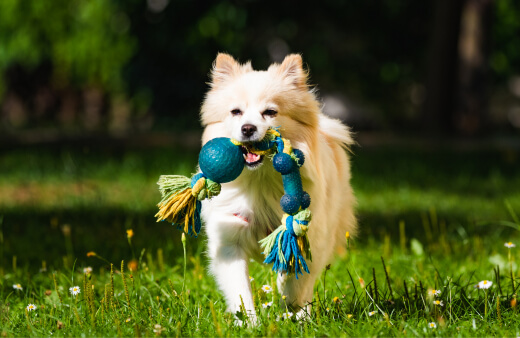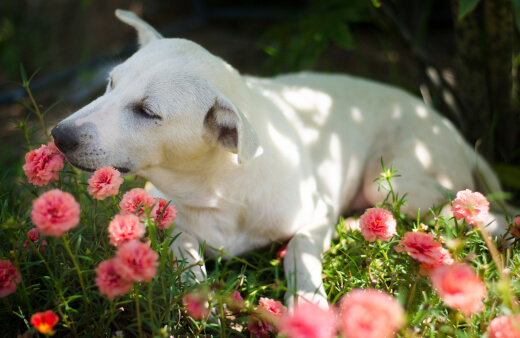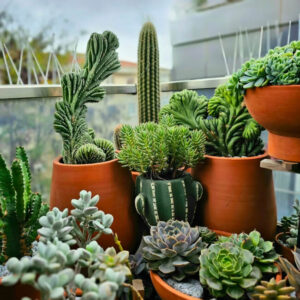Gardens are havens for most of us. A space where we can relax and enjoy all the hard work we’ve put in over the years. They help us connect with the environment around us and slow down just long enough to enjoy a cup of coffee in the shade of our favourite tree.
It’s no wonder, then, that gardens are being used in a variety of different healthcare settings to help people reconnect, engage and recover. But did you know that there are also dog sensory gardens? They’re a great way to allow your pup to safely explore their surroundings and provide lots of mental stimulation to keep your dog happy and healthy.
In this article, we’re going to take you through everything you need to know to create a safe, fun, and beautiful doggy garden that you can enjoy with your furry best friend.
More...
What is a Dog Sensory Garden?

As a dog owner and a gardener, you probably spend a lot of time outdoors with your pup. After all, we all know the importance of giving dogs enough exercise to keep them fit and healthy. But their mental health is also really important.
Puzzle toys, snuffle mats and dog daycare are great ways to enrich their lives and prevent undesired behaviour that arises from boredom or frustration. As is a dog sensory garden.
As you might have guessed, this is an outdoor area that is designed to heighten all your dog's senses:
- Sight
- Smell
- Taste
- Sound
- Touch
Sensory gardens for dogs can be as large or as small as you or your pup would like. They can include different areas, different dog-friendly plants and lots of things for your pup to explore and play with.
Fresh air, being in nature, getting their paws muddy and learning about the environment around them are all great ways to stimulate your pup’s brain. There are so many reasons why you should keep dogs stimulated, including preventing aggression, depression and hyperactivity.
And whilst a dog sensory garden is aimed at man’s best friend, it’s an area you can enjoy with your dog too. It’s also really fun to build! Is there a particular spot in your garden where your pup loves to sunbathe?
Make it into a sunny corner that you can both enjoy. Or why not try planting some dog-friendly herbs that can stimulate your pup’s heightened sense of smell but that you can also add to your favourite pasta dish?
A dog garden is the perfect place for you both to enjoy and bond.
How to Create a Sensory Garden for Dogs

The first thing you need to do is observe your dog and how they like to enjoy the space you already have.
Some things to think about are:
- Where do they like to sniff?
- Where do they like to sunbathe?
- Do they have a favourite corner to play in?
- Where’s their usual bathroom spot?
- Do they like water?
- Do they like to dig?
By asking yourself these questions, you’ll be able to plan the best sensory garden for your dog (and you!) to enjoy. After that, you can start to plan what plants for dog sensory garden and features you’d like to be part of the garden.


Get Your Free Guide:
Master Growing Australian Natives eBook
A Must Have Complete Guide for Every Australian Garden
Get Your Free Guide:
Master Growing Australian Natives eBook
A Must Have Complete Guide for Every Australian Garden
If you’re also planning a dedicated pet run or play area to complement the sensory garden, see our guide on Designing Pet Runs and Play Areas That Complement Your Garden.
Here are a couple of sense-based ideas that we love!
Sense 1: Sight
Dogs don’t see colour quite like we do. In fact, scientists believe that they see the world in much the same way someone with red-green colour blindness does. Two of the colours they can determine are yellow and blue.
Marigolds, sunflowers and zinnias are great dog-safe and yellow plants for you to pot up for your pup!
Sense 2: Smell
Smell is such an important part of any garden and it also has a huge role to play in a sensory dog garden. Dogs have a heightened sense of smell, so you can imagine just how amazing roses smell to them!
Luckily, roses are also a dog-safe plant, as are pansies and petunias (they’re also blue so it’s a win-win).

Sense 3: Taste
It’s really important to only plant dog-safe herbs and veggies in your garden. So, sorry, but that means no onions or garlic if you want to avoid an emergency trip to the vet. You also need to be careful with the fruit trees you plant as some stoned fruits can be toxic to dogs.
Try fragrant herbs that are safe for pups but which you can also enjoy. These include parsley, basil, and rosemary. Spread them out around the garden so they don’t overwhelm in one area and are also encouraged to check out different areas of your garden.
Sense 4: Sound
Sound isn’t always the first thing we think of when we start a new gardening project but it’s something that dogs love. Plants that rustle in the breeze, such as bamboo or wheat grass are great for doggy enrichment.
In autumn, you could also build a pile of leaves and hide your pup’s favourite toys in it. They’ll love the crunchy sound and rewards!
Sense 5: Touch
There are loads of great ways to include texture in sensory gardens for dogs. These include adding stones, pine cones, sand, logs, ramps and a comfortable area that they can relax in.
Even if you only have a small amount of outdoor space you can really make it into a fun area that’s designed with mental stimulation for dogs in mind. Add pot plants and puzzle toys for extra stimulation.
You can also add wind chimes or a small water feature which will help to relax and enrich them.

Christine Hough
Christine is the owner and operator of The Dog Dazzlers. The Dog Dazzlers is a purpose-built dog daycare and grooming facility in Burwood, Victoria.
We have experience with pups of all ages and breeds and make sure that all the dogs in our pack are happy and having fun.
We’ll send them back to you looking their best and full of stories of all the things they’ve learnt, the toys they’ve played with and the friends they’ve made.
Its Time to Set Up a Dog Sensory Garden
The most important thing to think about when creating sensory gardens for dogs is that they’re safe. You don’t want your pup to eat anything that could potentially be toxic. But, bearing this in mind, there are so many fun ways you can transform your outdoor space into one that benefits both you and your dog - regardless of size or budget!
Published on May 30, 2023 by Gary Clarke
Last Updated on September 18, 2025




